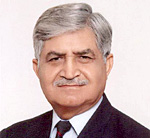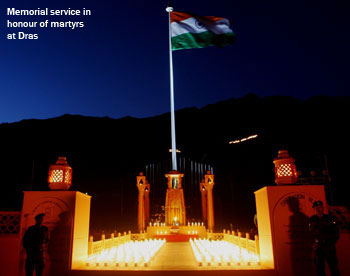INDIAN ARMED FORCES CHIEFS ON
OUR RELENTLESS AND FOCUSED PUBLISHING EFFORTS

SP Guide Publications puts forth a well compiled articulation of issues, pursuits and accomplishments of the Indian Army, over the years

I am confident that SP Guide Publications would continue to inform, inspire and influence.

My compliments to SP Guide Publications for informative and credible reportage on contemporary aerospace issues over the past six decades.
- Interim Defence Budget 2024-25 — An Analysis
- Union Defence budget 2024
- Indian Army: In quest of greater firepower and policy recommendations for gaps
- Indian Army Annual Press Conference 2024
- 6G will transform military-industrial applications
- Tata Boeing Aerospace Delivers 250 AH-64 Apache Fuselages, Manufactured in India
Lessons from Kargil War
Operation Vijay was a blend of determined political, military and diplomatic actions, which enabled us to transform an adverse situation into an emphatic military and diplomatic victory

On July 16, 2014, India celebrated the 15th anniversary of its victory in the Kargil War, which was forced upon it by Pakistan. A strategically conscious nation commemorates such historical national security events for three reasons: to remember and pay homage to those who sacrificed their lives for the nation’s future, to recall lessons that emerged from that event and to pledge for a safer and better future.
The Kargil War will always be remembered for (a) its strategic and tactical surprise (b) the self-imposed national strategy of restraint keeping the war limited to the Kargil-Siachen sector (c) military strategy and planning in keeping with the political mandate and (d) the dedication, determination, and daring junior leadership at the tactical level. In fiercely fought combat actions, on the most difficult terrain that gave immense advantage to the enemy holding mountaintops, we were able to evict Pakistani troops from most of their surreptitiously occupied positions. The Pakistani leadership was then forced to sue for ceasefire and withdrawal of its troops from the remaining areas.

Operation Vijay (codename for the war) was a blend of determined political, military and diplomatic actions, which enabled us to transform an adverse situation into an emphatic military and diplomatic victory. As two Prime Ministers of Pakistan later acknowledged, “Kargil war was Pakistan’s biggest blunder and disaster.”
The war highlighted, once again, two basic assumptions for war planning: (a) despite whatever effort there may be to prevent it, there may be a war and (b) we cannot predict with certainty the pattern of war for which we prepare ourselves. On the strategic front, two major lessons that stood out were (a) although possession of nuclear weapons has made an all-out war less likely, so long as we have border and territorial disputes (like with Pakistan and China), Kargil type military conflicts could not be ruled out, and (b) an irregular or proxy war could easily escalate into a limited conventional war.
The war also emphasised that loss of territory, however remote or small, is just not acceptable to the public at large or to the political authority in India. Every Indian feels that every inch of territory has to be defended. The strategic impact of such a notion at the national level is that the armed forces cannot trade space (losing some here but trying to capture somewhere else where there is greater strategic advantage!) for major offensive manoeuvres elsewhere. This is a peculiar strategic problem and a handicap faced by the Indian military, which intensifies in a limited war scenario. This implies that much greater attention has to be paid to intelligence, surveillance, and close defence of the borders or lines of control.
The absence of a proactive politico-military strategy in India had resulted in a persistent belief among Pakistan’s military leaders that India can be pushed for political and military advantages. Since Kargil War, such an impression has been further strengthened in the Indo-Pak military standoff in 2001-02 and 26/11 mayhem in Mumbai. This has seriously eroded India’s military deterrence. Many defence analysts now feel that an activist retaliation policy against Pakistan has become a political imperative for India.
At another level, we have to seriously consider the conventional and subconventional conflicts proceeding at multiple levels below a nuclear threshold. These factors have made the Indian armed forces work on a limited war doctrine and to consider how small or big is the space between a proxy war and a conventional war?
The Kargil War involved a much greater level of integration of politics and military planning and execution. At military strategic level, inter-services planning were excellent, primarily because all three Service Chiefs had known each other since their National Defence Academy days and also worked together as Vice Chiefs. They had ready access to the Cabinet Committee on Security and the Prime Minister. The National Security Adviser, late Brajesh Mishra, was an ideal trouble shooter. In the unpredictable strategic and conflict environment that exist presently, it has become essential to maintain close and inter-active relations amongst military and political leaderships all the time.
Another aspect related to the nuclearised strategic environment was that even after the diplomacy has run its course and a decision to employ the military is made; the political leadership seldom allows autonomous conduct of the war to the military. In practice, therefore, we are seeing a continuing erosion of the dividing lines between war and politics.
Some other important lessons of the Kargil War were:
- Successful outcome of a border war depends upon our ability to react rapidly. The new strategic environment calls for faster decision making, versatile combat organisations, rapid deployment and synergy amongst all elements involved in the war effort, particularly the three services.
- A conventional war may remain limited because of credible deterrence and escalation dominance. Such deterrence may prevent a war; it will also give more room for manoeuvre in diplomacy and in conflict.
- Information operations are important due to much greater transparency of the battlefield. The political requirement of a military operation and to retain moral high ground (and deny that to the adversary) needs a comprehensive media and information strategy.
All-weather Surveillance
The Kargil War had highlighted gross inadequacies in all-weather surveillance capabilities. Since then, this capability has been made up with indigenous satellites and aerial imagery with synthetic aperture radar. We have also acquired effective unmanned aerial vehicles, and most importantly, acquired and deployed hand-held thermal imagers, surveillance radars and ground sensors along the lines of control. Individual service and joint services doctrines have been revised. Some Special Forces units have been added to the strength of each service.
National Security Review and Higher Defence Management
After the war, it was felt that India required a holistic national security review as well as re-thinking on the nature of conflict in the new strategic environment and conduct of wars. This was done under a Group of Ministers. The National Security Review-2002 recommended several meaningful reforms to improve the Higher Defence Control Organisation, its systems and processes. Unfortunately, these were either not implemented, or implemented only cosmetically.
India now has a National Security Council. But there is no official document outlining its broad national security (including defence) policy and strategy. The government has hesitated in spelling it out due to lack of political consensus on its policies and the inability to address the crucial issues of coordination to formulate and address national security. There is no policy document or a white paper on broad national security policy and strategy for the near or long term. The absence of a coherent policy tends to make our responses ad hoc and less convincing.
The National Security Review-2002 had recommended creation of the post of Chief of Defence Staff to provide single-point military advice to the government and to resolve substantive inter-service doctrinal, planning, policy and operational issues. This is necessary because in India, turf wars, inter service rivalries, bureaucratic delays and political vacillation in decision making become major hurdles in defence planning which is tardy, competitive and thus uneconomical. Due to lack of political will and inter-service differences, this important recommendation was not implemented. Selective and cosmetic implementation of recommendations, without changing rules of business, ensured a status quo in the Higher Defence Control, its decision making processes and poor civil-military relations.
In June 2012, the UPA Government appointed the Naresh Chandra Committee to carry out yet another national security review. However, till date, its recommendations have neither been de-classified nor implemented. A strong, competent and committed political leadership is required to bring about improvements in the security policies, Higher Defence Control Organisation and its systems, including its rules of business.
This realisation has made the government order yet another review under the Naresh Chandra Committee. If the recommendations of this Committee—now under study in the government—are processed and implemented in the same old manner, India may lose yet another opportunity to make its national security more effective.
Deficiencies in Weapons/Equipment and Modernisation
When Kargil War broke out, our holdings and reserves of weapons, ammunition and equipment were in a depleted state due to continuous lack of budgetary support, tedious procurement system, and raising of Rashtrya Rifles units without sanctions for their weapons and equipment. To the media, I had to state, “We will fight with whatever we have”.
It is evident from the letter written by the former Chief of Army Staff (now a Minister of State in the NDA Government) to the Prime Minister on March 12, 2012 that deficiencies in our war wastage reserves continue. He complained that the army’s air defence weapon systems were obsolete, the infantry was deficient of crew served weapons and lacked night fighting capabilities, and its tank fleet was devoid of critical ammunition, and alleged that there was ‘hollowness in the procedures and processing time for procurements as well as legal impediments by vendors’.
The government has yet to rectify this chronic problem which has dogged the nation for decades. As a result modernisation of Indian armed forces continues to lag behind due to inadequate self-reliance, fear of scams and reluctance to procure essential equipment from abroad. Despite a large network of Defence Research and Development Organisation laboratories, ordnance factories and defence public sector undertakings, we continue to import 70 per cent of our weapons and equipment.
The government desires that private sector invests in defence industry and obtains higher technology from abroad. But due to vested interest of the defence public sector and its bureaucratic control, it has failed to provide a level playing field to Indian and foreign private sectors. The Defence Acquisition Council and Procurement Board, established after the Kargil War, have not succeeded in speeding up processes for development, acquisition and procurement.
There is no point talking about revolution in military affairs, information systems and net centric warfare if we cannot induct relevant weapons and equipment in time. Efforts towards modernisation of the armed forces have not borne fruit, primarily due to the absence of holistic and long-term defence planning.
Conclusion
The Kargil War was not the first time when Pakistan initiated a war. And we must not assume that it would be the last time. India will remain vulnerable to such threats along its disputed borders unless it builds a credible will and capability to deter and dissuade its adversaries. An enduring lesson of Kargil War, indeed most wars, is that for national security, sound defence enables sound foreign policies.
The ongoing dialogue between India and its two territorial-hostile neighbours may result in peaceful, stable relations. The nation and its armed forces can hope for the best; but they must remain prepared for the worst.
The writer was the Chief of Army Staff during Kargil War.





